
Full text loading...
Semiconductors have gained recognition as efficient photocatalysts for the degradation of antibiotics in water. However, their performance is limited due to poor absorption of light, recombination of electron-hole pairs, and poor recovery from an aqueous solution. This study reviewed the inclusion of semiconductor nanoparticles in a metal-organic framework (MOF), forming nanoparticle@MOF composite to overcome these challenges. Three methods including ship-in-bottle, bottle-around-ship, and one-step synthesis were identified for the synthesis of nanoparticle@MOF composite. Among the synthesis methods, the one-step method remains promising with high prospects. Nanoparticle@MOF composite has exhibited high efficiency in removing antibiotics in an aqueous system utilizing visible light as a photo source for promoting the process. Despite the success achieved, there is a need for large-scale studies and cost evaluation to understand better the feasibility and economic implications of the nanoparticle@MOF composite technique as an affordable technique for the purification of an antibiotic-contaminated water system.

Article metrics loading...

Full text loading...
References


Data & Media loading...

